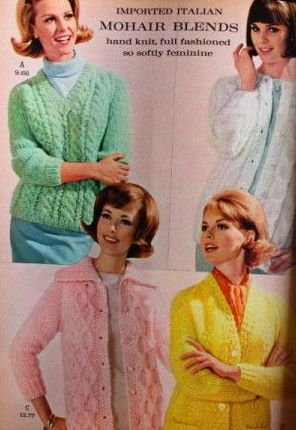Mohair has been a darling of the vintage fashion world for the past 2-3 seasons. Dealers are chasing it, customers are snapping it up at seemingly ever-increasing prices. In addition to being a durable and warm natural fiber, mohair garments are often playful, colorful and unique. Styles ranging from the 1950s-y2k are relatively easy to find, so what’s not to love?
But what is mohair exactly? Glad you asked. Mohair- like wool- is an animal-derived fiber and comes from the Angora goat. Not to be confused with angora fiber which is also fuzzy and comes from Angora Rabbits. Both animals originate from the same region of Turkey: Ankara, a.k.a. “The Cozy Lands” (just kidding about that last part).

South Africa, the United States, and Turkey are currently the 3 largest producers of mohair fiber. Texas, with a herd of 200,000 goats accounts for 90% of the USA’s production. Who knew?
Angora goats are sheared twice a year for their coats. The fibers increase in diameter with the age of the goat. The finer, softer hair from younger animals is used in clothing + accessory production and yarns.
Mohair takes dye exceptionally well, making it a favorite among kooky home knitters and high-end men’s suiting ateliers alike.

In many mohair yarns and garments you’ll typically find the mohair is blended with other fibers: often wool, and/or acrylic or nylon. The result gives you all the sheen, luster, and texture of mohair with some added spring and grip for holding shape that smooth mohair fiber alone lacks.

Mohair had a big a moment in the late 50s/early 60s with mohair cardigans and sweaters (as well as winter accessories). It resurged in the grunge movement of the early 90s, along with vintage knits and thrifted style more generally. This was followed closely by an interest in deconstructed mohair knits on the runways in the early aughts (think Junya Wantanabe for Commes des Garcon). This might partially explain why it feels like its trending again right now, along with other 90s and y2k fashion moments.

I also think there’s been an increased interest in “cottage industry” fashion: totally unique pieces made by hand one at a time, that look and feel made by hand, as a response to fast fashion. The Nongrak is one great example of this trend at work in a contemporary setting. Vintage 80s pieces from labels like Susie Lee and Ann Arundell also fit this category.

In any case, mohair is a fabulous fiber with many applications and ways to love it.
This brings me to the second half of this blog: the most famous mohair of all.
Kurt Cobain wore a thrifted 1960s mohair cardigan to Nirvana’s MTV "Unplugged" performance in 1993. It was a piece he apparently wore frequently during that time until his death a year later. The unassuming, rather dingy cardigan was gifted to a house keeper by Courtney Love shortly after his passing and eventually sold at auction in 2015 for $137,500. It came up for auction again in 2019 and sold for a whopping $334,400, right as mohair was beginning its most recent surge in popularity.

Which begs the question: did the sale of Cobain’s cardigan single-handedly move the needle on mohair back in 2019? Or was it riding a wave already set in motion by larger fashion forces at work?
We may never know. But fear not, if “90s Seattle Grunge Scene” is your mohair flavor of choice, 1960s cardigans very similar to Cobain’s (and likely cleaner) can be found from vendors online for around $200-400.
What's We, Mcgee's current favorite? These vintage Hayfield knitting patterns:

Sources:
https://www.svrn.com/blogs/features/the-resurgence-of-mohair
https://www.bbc.com/news/world-us-canada-50199103
https://en.wikipedia.org/wiki/Mohair

